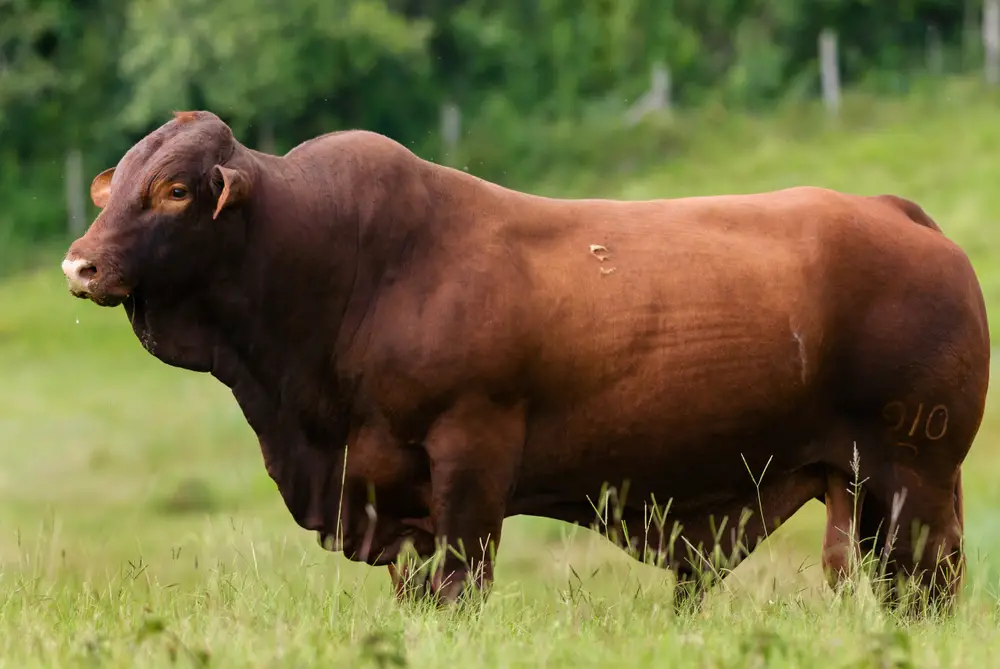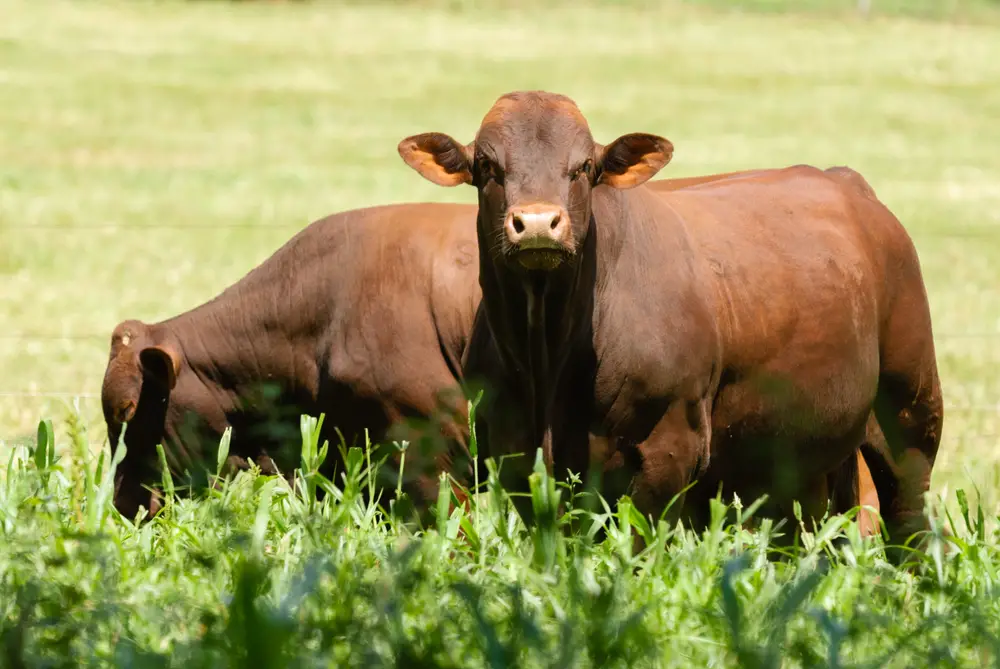Known for their extreme hardiness and adaptability to extreme heat, Santa Gertrudis cattle thrive in both drought conditions and tropical weather. They are known as the first beef breed created in the USA and were developed in Texas.
Containing both Bos Indicus and Bos Taurus blood, Santa Gertrudis cattle are a hybrid breed created from 5/8 Shorthorn cattle and 3/8 Brahman cattle.
This article will cover the history of Santa Gertrudis cattle, and shed light on the remarkable characteristics of this breed that make it perfect for cattlemen looking for a profitable, hardy breed.
Table of Contents
Where Does The Santa Gertrudis Come From?
At the turn of the 20th century in the United States, a rancher named Robert Kleberg Jr of the King Ranch was seeking to create a breed that would thrive in the drought conditions of south Texas. He was looking for a heavy beef cattle breed that could thrive in extreme heat conditions and be resistant to local pests and disease.
A nearby rancher named Thomas O’Conner donated a bull to King Ranch in 1910, which was cross between a Brahman and a Shorthorn. This bull managed to jump a fence and mate with several purebred Shorthorn heifers.
As luck would have it, there were several offspring born from his efforts, one of which was a bull named Chemmera. He was used as a breeder and 9 years later, Kleberg mated a cow that was a descendent of the originally donated bull to a Brahman bull and produced a dark-red colored bull that had desirable characteristics, which he named Monkey.
Monkey became a sire and the animals he produced were all of superior quality. Eventually, these animals formed the foundational herd of the Santa Gertrudis breed. The name Santa Gertrudis came from the hills of Santa Gertrudis, where the King Ranch was located.
In 1940, the Santa Gertrudis breed was recognized officially by the United States Department of Agriculture, making it the oldest beef breed native to the US.
After they were recognized by the USDA, ranchers in other countries including Australia, Mexico, and South America began to purchase this breed of cattle for use in seedstock operations and commercial herds.
Though they are known throughout the world, they are still considered America’s first beef breed, according to Santa Gertrudis Breeders International (SGBI) which is the official registry for Santa Gertrudis cattle in the United States.
Santa Gertrudis cattle have been crossed with Red Angus and Gelbvieh to produce Santa Cruz cattle, which were also developed at King Ranch. Santa Gertrudis cattle have also been crossed with Hereford cattle to produce a cross with superior milking abilities.
Santa Gertrudis Cattle Breed Characteristics
| Official Breed Name | Santa Gertrudis |
| Scientific Name | Bos taurus indicus |
| Origin | United States |
| Appearance | Bulls have thick necks and bulls have a hump between their shoulders Bulls are known for heavy muscling Bulls also have thick and powerful legs, and short, compact faces Cows have longer faces than bulls and a more rectangular form Cows have a pronounced rump and slender legs Both genders can be either polled or horned Both genders are a cherry red color with slick coat. |
| Calf Weight | 85lbs at birth |
| Mature Cow Weight | 1350lbs to 1850lbs |
| Mature Bull Weight | 1700lbs to 2200lbs |
| Ready To Breed | 13 to 15 months |
| Gestation Period | 279 to 287 days |
| First Calvings | 2 years |
| Time to Slaughter | 18.5 months |
| Carcass Weight | 645lbs |
| Expected Lifespan | 20 years and productive for roughly 15 years |
| Known For | Beef production Docile temperament Hardiness and adaptability Parasite and disease resistance Fertile in extreme heat with active sweat glands High carcass yields with minimal waste Large rib-eye area Feed conversion ratios |
| Climate | Tropical, hot climates |


What Is So Special About Santa Gertrudis Cattle?
They are incredibly profitable feeders and one of the most efficient producers of beef of all beef cattle breeds. They gain weight rapidly and have high feedlot performance.
These statistics are quite impressive:
- Some bulls have shown they can convert 13lbs of feed into 2lbs of muscle
- Slaughter yield percentages regularly fall between 60% and 65%
- Average USDA Yield Grade 2.98
- Over half of Santa Gertrudis carcass score Yield Grade 1s and 2s
- REA (rib-eye area) average is 14 sq inches
Beef industry data was amassed and released to the public on Santa Gertrudis steers showing that out of 3,800 steers, they graded 70.9 Choice and Prime, 8.6 higher than the plant average of 62.3%.
Santa Gertrudis cattle are shown to hit endpoint targets as well as please consumers.
Why Should I Raise Santa Gertrudis Cattle On My Farm?
- Steers excel in feedlot growth tests, regardless of whether they are pure breed or crossbreed
- Calves are known for low birth weight and rapid weight gain post birth
- Achieve high weaning weights and weight gain of 4.4lbs per day is common
- Heifers and bulls will wean at 500lbs
- Non-selective forager that converts forage well
- Long productive lifespans, cows still birthing calves up to 15 years
- Milk is excellent quality with high butterfat percentage
- Cows have excellent mothering abilities
- Cows will watch over groups of young while other cows graze
- Can be used as both feedlot cattle and grass-fed cattle
